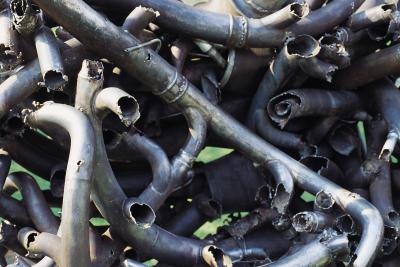
When the exhaust manifold studs break on a Ford F150, the driver will notice a puttering sound on cold start-up because the backside of the exhaust manifold will vibrate, smacking into the engine head. Eventually the oxygen sensors can receive erroneous readings due to an increase in the oxygen passing over the sensor. This could possibly lead to engine performance problems from the change in fuel trim values. In extreme cases your check-engine light might pop on. With the use of pneumatic tools and a long afternoon you can take care of problem.
Determine which manifold is leaking by looking on the backside, closest to the passenger compartment, with a flashlight, for broken studs or visible black soot.

Evaluate condition of the nuts and bolts around the manifolds and the exhaust Y pipe, looking for rust. Spray all nuts and studs on the manifolds with a penetrating oil lubricant, such WD40.

Gather all of the tools and parts you will need to finalize the project so you don't need to worry about going out to get a tool or part once your Ford F150 is torn apart.
Jack up the front of the Ford F150 onto jack stands.
Remove the wheel on the side where the manifold is leaking, using a socket and ratchet.

Remove plastic wheel wells, using ratchets and a pry bar.

Remove the four exhaust nuts that connect the Y pipe to the exhaust manifolds. Depending on the level of rust degradation on the nuts, it might be necessary to use extractor sockets to remove.
Remove the exhaust gas recirculation, or EGR, tube if you working on the left side of the manifold. Typically it will be so rusted you will need to cut the tube, using the metal hacksaw, as close to the manifold as possible. Otherwise skip to the next step.
Remove the all eight nuts from the exhaust manifold. When removing, don't be surprised if the stud turns and is removed with the nut or breaks off as you turn. Typically, the back nuts are the ones that will break off due to rust and fatigue. Then, remove any remaining exhaust studs that did not come off with the nuts.
Remove the exhaust manifold and discard the gasket.
Remove any broken studs by attempting to turn with extractor bits and a ratchet. If you are unable to extract, use the 90-degree drill, preferably with counter-clockwise drill bits to assist in removal of studs, drilling a hole into the center of the stud, which might release it. Increase drill bit size, as necessary, to remove. Once the layer of rust on the stud is removed from the seat of the hole in the engine head, the stud will freely turn out.
Remove the top portion of the EGR tube from the EGR valve with a wrench, if you are working on the left manifold.
Replace the manifold if the EGR tube and nipple are so heavily rusted that you can't remove them.
Access the amount of rust and wear on the exhaust manifold. Replace if there is heavy rust build up on the face or clean by using the drill grinder.
Install new EGR tube and nipple if you are working on the left manifold.
Position new manifolds in place, over the gaskets, while lightly turning in the studs by hand.
Tighten the nuts top to bottom, right to left. In other words: tighten the top right, then the bottom right; tight the second from the right on the top followed by the second on the right bottom, and so on. Always start from the side closest to the back side of the engine.
Put the Y pipe back in place and tighten the bolts.
Reconnect the EGR valve to the exhaust manifold upper fitting.